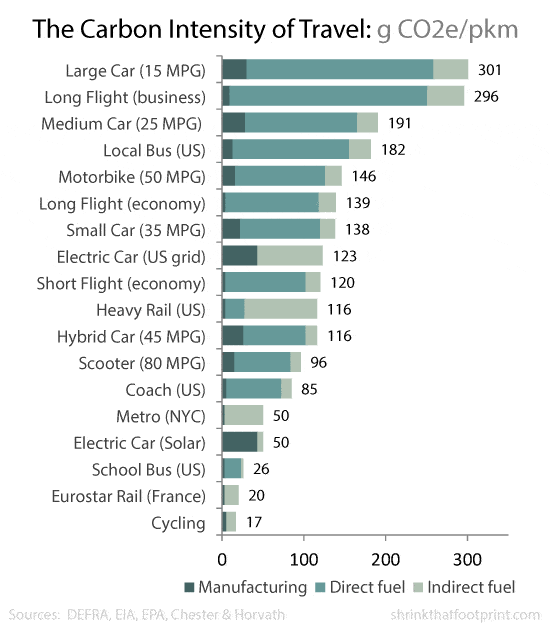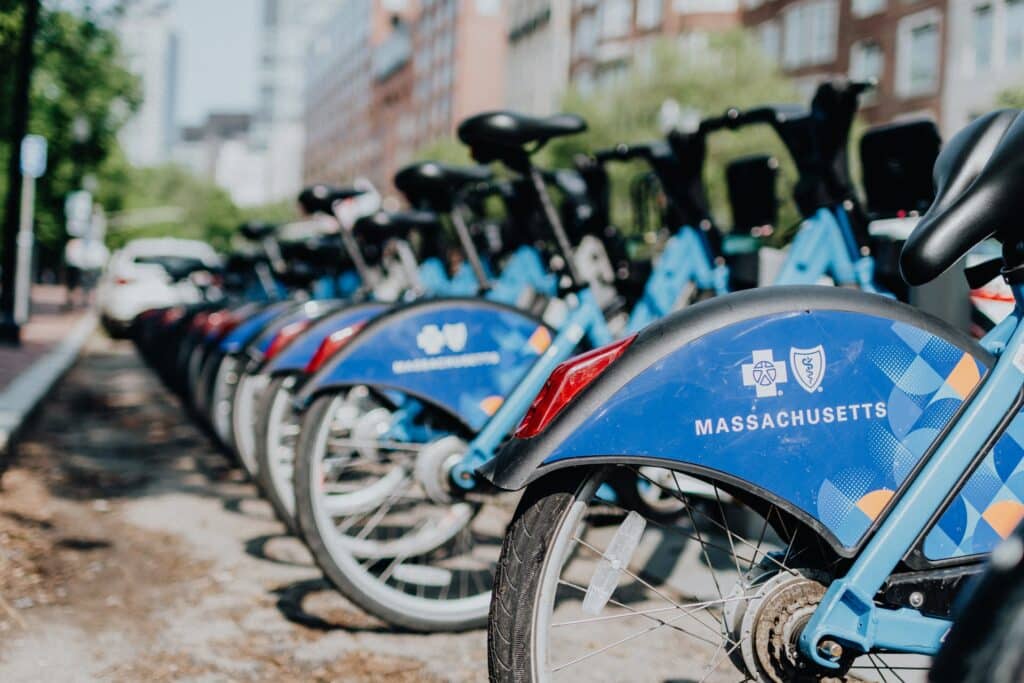Transportation Affects Two Thirds Of Carbon Emissions
Transport is responsible for around a seventh of greenhouse gas emissions globally. Of these emissions almost two thirds are the result of passenger travel while the rest is due to freight. Therefore, sustainable transportation for passengers is a big deal for climate.

In the chart above (data from DEFRA, EIA and EPA), which comes from our new eBook Emit This, we compare carbon intensity of different types of passenger transport on a per passenger kilometer basis. Using it we can explain some elements important to the development of a sustainable transport system.
1) Fuel Economy – Higher Is Better
Our chart today compares the carbon intensity of different transport modes, per passenger kilometer. The better fuel economy gets the lower emissions. If you just look at the cars you’ll see the large car (15 MPG) has emissions almost three times that of the hybrid car (45 MPG).
By improving fuel economy we can get the same mileage while generating fewer emissions. Something that is achieved by making engines more efficient, vehicles lighter and bodies more aerodynamic.
Improving fuel economy has a direct impact on reducing carbon emissions, and advancements in automotive technology are facilitating this.
Technologies like regenerative braking, which recovers energy usually lost during braking, and cylinder deactivation, which allows an engine to run on fewer cylinders under light load, are among the innovations that enhance fuel efficiency.
These modern features not only make vehicles more efficient but also serve as transitional steps towards more sustainable transportation solutions.”
In 2023, as electric vehicles are poised to overtake combustion-engine cars by 2030 according to a BloombergNEF report, improvements in fuel economy are increasingly seen as a transitional measure en route to a more sustainable future in transportation.
2) Occupancy – Increase Passenger Number For Efficiency
The cheapest and simplest way to lower the carbon intensity of a passenger kilometer is to stick more people in the vehicle. In each of the figures above car occupancy is assumed to be an average of 1.6 passengers (including the driver). But most cars are designed for 5 people.
If you take a look at the bus examples the importance of occupancy becomes even more stark. The local bus example has emissions seven times higher than the school bus. While there routes may vary a little they are both diesel buses. The main difference is that the school bus has very high occupancy, unless the school bus is very empty.
With notable exception of flying public transport tends to have quite low carbon emissions on a per kilometer basis, due largely to having relatively high occupancy.
But don’t forget, a flight means potentially traveling thousands of kilometers across the globe. This will generate hundreds of kilograms to tons of CO2 per trip.
3) Electrification – Connecting To Grid Is Less Carbon Intensive Than Gasoline And Natural Gas
Electric cars using low carbon power have footprints less than half that of the best hybrid, even after you account for their larger manufacturing footprint.
Right down the bottom of our chart is the high-speed EuroStar rail which uses low carbon French electricity. The electrical grid of France is so low in carbon because of their high use of nuclear power.
Though not on our chart, the lowest carbon transport on earth is probably electrified public transport in a place like Norway where electricity generation is almost carbon free. Norway’s electricity comes from super clean nuclear, hydro and wind sources.
In the absence of breakthroughs in second generation biofuels electrification is the most important pathway to low carbon transport.
While there is a natural tendency to obsess about the electrification of cars, there are lots of interesting innovations occurring in the electrification of rail, motorbikes, scooters and bikes.
For example the Nissan Leaf is an electric car that takes energy from the grid and charges the battery, and does the reverse: take energy from the battery and sell it back to the grid. This is called “V2G” or “vehicle to grid” technology that we’ve covered.
This has the effect of making the Leaf a storage device out of the battery which takes part in shifting the usage of power from peak to off-peak hours.
4) Pedal Power – Biking Is Great For Reducing Carbon

They may be a bit low tech for some, but when it comes to carbon emissions bicycles are pretty cutting edge. Even when you account for the foodprint of excess energy used when cycling, the humble bike is incredibly low carbon.
This carbon is coming from the passenger, you! When you pedal the bike, you’re the energy source. Therefore a combination of a human power source and a bike is the reason for the low carbon.
Bikes have obvious limitations around speed and distance, but for short trips in places with good infrastructure they are hard to beat in terms of carbon. They also have a great synergy with public transport systems like intercity rail.
We talk about benefits of electric bikes here specifically. Electric bikes will add to the carbon emissions very slightly. Fortunately electric bikes are very efficient. Consider the Evelo electric bike battery which operates at 48 V and has 15 amp hours.
This translates to 720 kWh. The stated range is 50 miles on a full charge. That translates to 50 miles per 0.72 kWh or 69 miles per kWh. In comparison the Telsa 3 and Nissan Leaf go 4 and 3 miles per kWh. Therefore, the electric bike is 15-20 times more efficient than an electric vehicle.
The answer is simple – a huge amount of energy goes into moving not just the passenger but also the body of the car. It’s a surprise that the car isn’t even less efficient which speaks to the marvelous engineering in electric cars.
5) Urbanization – Both Improve And Worsen Carbon Emissions
Each of the first four elements we have described above refers to improving the carbon intensity of transport. But emissions are a function of both how we travel and how far we travel. One thing that tackles both of these issues is the trend towards urbanization.
High occupancy and shorter distances in cities offset poor fuel economy in cities
People who live in cities have lower transport emissions. Fuel economy may be lower in city traffic but that is more than made up for by the fact that city dwellers drive far less.
Electrification of public transport is more economic and practical in cities. Occupancy on public transport systems is much higher. And access to infrastructure for both cycling and walking is often better.
Intra-city sustainable transportation will increase in importance to carbon reduction
In 1950 less than 30% of the world’s population lived in cites, by 2010 that figure was over 50%, and by 2030 it is expected to surpass 60%.
This natural trend to urbanization is a huge opportunity to for lowering both distance travelled per person and the carbon intensity of that travel.
Congestion Charges in Europe
Regulations like congestion charges that exempt electric cars will add carbon economics to city travel. In Europe, cities like London, Stockholm, and Milan have successfully implemented congestion charges. London, for instance, introduced its congestion charge in 2003, and it has led to a 30% reduction in traffic within the charging zone.
Stockholm’s congestion tax, implemented in 2007, has reduced traffic by about 20% and lowered emissions by 10%. Milan’s Area C, a low-emission zone in the city center, has seen a 40% reduction in harmful particle emissions since its inception.
Congestion Charges in the USA
In the United States, New York City is set to become the first American city to implement a congestion pricing scheme, originally slated for 2023 but expected to be enacted in 2024. The plan aims to reduce traffic in Manhattan and generate revenue for public transportation improvements.
While the U.S. has been slower to adopt this strategy compared to Europe, the New York model, if successful, could serve as a blueprint for other American cities looking to reduce carbon emissions through transportation regulation.
How you can take action to promote sustainable transportation
You have at your disposal two choices. You can make personal decisions on the transportation to take, and you can make your voice heard through voting on government-based infrastructure solutions toward sustainable transportation.
One way the government is promoting sustainable transportation is by investing in public transportation. The government is also working on improving the fuel efficiency of vehicles and promoting the use of alternative fuels.
Those are our five elements of sustainable transport: fuel economy, occupancy, electrification, pedal power and urbanization!
Lindsay Wilson
I founded Shrink That Footprint in November 2012, after a long period of research. For many years I have calculated, studied and worked with carbon footprints, and Shrink That Footprint is that interest come to life.
I have an Economics degree from UCL, have previously worked as an energy efficiency analyst at BNEF and continue to work as a strategy consultant at Maneas. I have consulted to numerous clients in energy and finance, as well as the World Economic Forum.
When I’m not crunching carbon footprints you’ll often find me helping my two year old son tend to the tomatoes, salad and peppers growing in our upcycled greenhouse.
